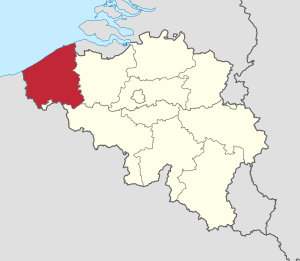 | WARNING: Due to the outbreak of the contagious disease COVID-19 (see coronavirus pandemic), caused by the virus SARS-CoV-2, also known as coronavirus, there are travel restrictions worldwide. It is therefore of great importance to follow the advice of the official bodies of Belgium and Netherlands to be consulted frequently. These travel restrictions may include travel restrictions, closure of hotels and restaurants, quarantine measures, being allowed to be on the street for no reason and more, and can be implemented with immediate effect. Of course, in your own interest and that of others, you must immediately and strictly follow government instructions. |

West Flanders is the westernmost province of Belgium and has Bruges as capital.
Regions
Towns
- Bruges - the capital and largest city of West Flanders
- Kortrijk
- Ostend - coastal city
- Roeselare
- Ypres
- Diksmuide
- Veurne
- poperinge
- Blankenberge
- Harelbeke
Other Destinations
- Beernem
- The Gavers - Nature area near Harelbeke and Deerlijk.
- Provincial domain Raversijde
Info
Under the French occupation, the county of Flanders was dissolved in 1795 and two French departments were formed from the area. The western part of the county became the department of the Lys. After the Allied liberation of 1815, this department became the Dutch province of West Flanders and then the Belgian province of this name. After the language border was established in 1962, the province lost the current Hainaut municipalities of Komen and Mouscron.
Tourist Office
The Tourist Office of this province is called WestToer.
Language
The official language in West Flanders is Dutch. In the province, the typical West Flemish dialect is mainly used as colloquial language. West Flemish is the liveliest and most widely used regional language in Flanders, although this dialect has also been in decline among the youngest generation for some years now.
Also adjacent to the language border are the municipalities with facilities of Spiere-Helkijn and Mesen, where a limited minority of French speakers can use their own language when communicating with the municipal authorities.
Arrive
The main highways that cross the province are the E40, E17, A19 and E403.
The most important railway lines are Ostend/Bruges-Ghent, Kortrijk-Ghent and Kortrijk-Lille. The most important stations are Bruges, Ostend and Kortrijk.
Public transport in the province of West Flanders is mainly organized to and from the cities of Bruges, Kortrijk and Ostend. Bus transport in the province is operated by the Flemish Transport Company De Lijn.
Travel around
With the coastal tram you can travel almost the entire coastline from De Panne to Knokke.
To look at
- Bruges city center
- Ypres (Cloth Hall, Menin Gate, Ypres Fortresses, etc...)
- The Flemish coast
- Into the iron tower Diksmuide
- Long Max Museum in Koekelare
To do
Those who visit the Flemish coast can sunbathe on the beach and/or sit on a terrace on the dike.
Food
- The Carmelite - Star restaurant in Bruges (see page Bruges).
Going out
stay overnight
Safety
It is very safe in West Flanders, the cities of Bruges and Kortijk are also safe, only the nightlife area of Ostend is better avoided during the late night hours. The same warning as for other big cities is this: the presence of many tourists also attracts some suspicious figures, don't be careless.
all around
West Flanders borders the province in the east East Flanders, in the north on Dutch Flanders in Zealand and in the south to the region French Flanders, in the French department north.
| Regions of West Flanders |
|---|
Belgium coast · The Westhoek · Bruges Surroundings · The Lys region |
| Provinces of Belgium |
|---|
Antwerp · Hainaut · shutter · Limburg · Luxembourg · Namur · East Flanders · Flemish Brabant · Walloon Brabant · West Flanders |

